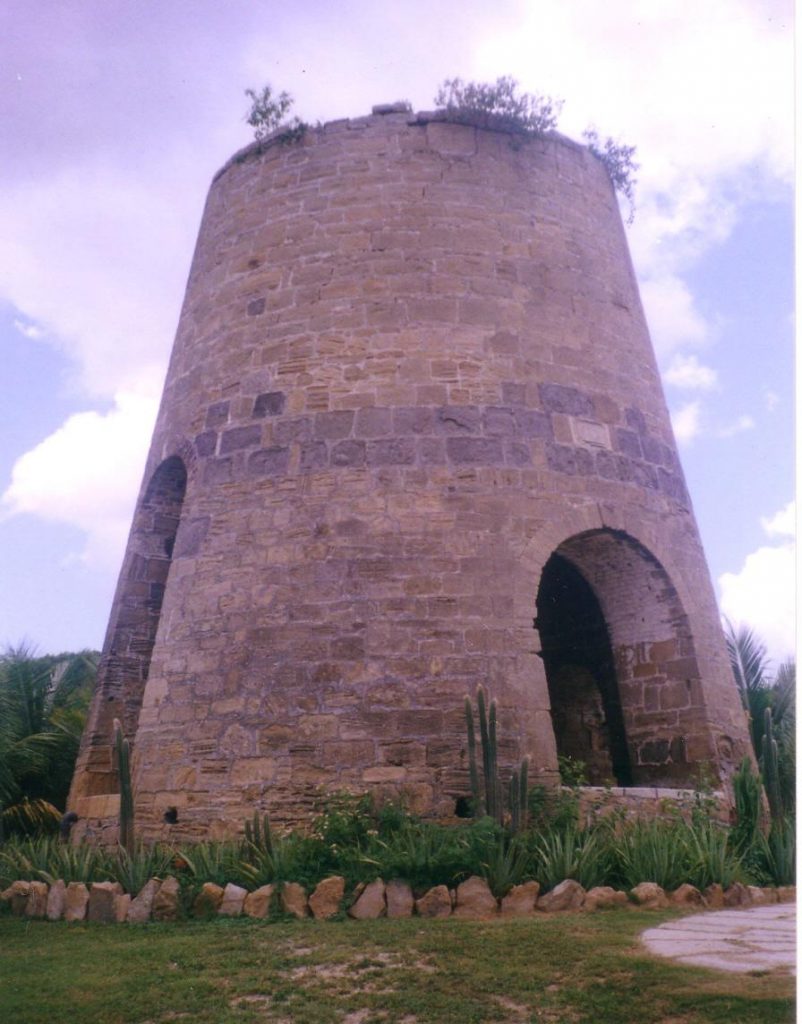About
Type: Extant
Parish: St.John
Founding date: 1750
See on Google Maps!

Current Status
The original sugar mill still stands on this plantation site, recently refurbished by the owners of the Galley Bay Hotel, which contains many artifacts found on the property during the construction of the surrounding area. The mill serves as the main shoreside entrance to the hotel, making a significant statement before guests are taken across the water of the pond to the hotel itself, which sits on the beach. The beach is one of Antigua’s finest but does feature heavy swells during the winter months. The Galley Bay Resort has taken over 40 acres of the hillside, offering terrific views of Deep Bay and the Caribbean Sea.
Estate Related History/Timeline
A rectangular stone above the main arch of the mill bears the date 1845, suggesting it must have been repaired following the earthquake that struck Antigua that year.
In 1852, the estate was owned by Inigo Freeman Thomas, who also owned Freeman’s (Friar’s Hill, #11), 365 acres, and Winthorpe’s (#56), 231 acres, as well as Galley Bay. In 1872, under the ownership of F. Thomas, the estate was used as a grazing farm for cattle.
In 1940, the Antigua Sugar Estates reissued 18,000 shares at £1 each to three members of the DuBuisson family (James Memoth. Mrs. Edith Manus, and William Herman; see Tomlinson’s, #17), as well as Alexander Moody-Stuart and Judith Gwendolyn Moody-Stuart. This marked the final shift toward the next generation of ownership. George Moody-Stuart declined the shares offered to him (Antigua Syndicate Estates, minutes of January 4, 1940, and May 1, 1940.)
The firm continued to control Gunthorpe’s (#64), Cassada Gardens (#13a), Paynter’s (#61), Tomlinson’s (#17), Fitches Creek (#67), Donovan’s (#65), North Sound (#66), Cedar Valley (#42), and Five Islands (#31) as well as Galley Bay.
On August 1, 1943, Gunthorpes Estate Ltd. was restructured (see Gunthorpe’s, #64) into a new company renamed Antigua Syndicate Estates, Ltd. Five Islands and Galley Bay were the only two estates retained by the Moody-Stuarts.
Deep Bay, the body of water in front of the Royal Antiguan Hotel and beach, has a long history dating to Archaic times in 1,400 BC. Many conch shells and stone hand axes have been found at the edge of the salt pond close to the Royal Antiguan Hotel’s swimming pool. Those artifacts are in the Museum of Antigua & Barbuda in St. John’s.
Fort Barrington, located on Goat Hill overlooking Deep Bay, was first captured by Royalist Prince Rupert during Oliver Cromwell’s 1652 revolution. It was taken again in 1666 by the French when they landed at Deep Bay and captured the eight guns at the Fort, routing the British troops. The French occupied Antigua for a very short period of about six months when the English regained control of the island through the Treaty of Breda.
The submerged wreck in Deep Bay is the steel sailing barque “Andes”. She displaced 866 tons and was carrying a cargo of 1,330 barrels of pitch, which she was transporting from Trinidad to Chile on June 5, 1905. The cargo caught fire, so the “Andes” put into Antigua off Sandy Island. She was later moved to Deep Bay to avoid obstructing shipping in and out of St. John’s harbour. Two hundred barrels of the pitch were salvaged before the “Andes” was finally consumed by flames. The tip of the boat’s mast protrudes through the water surface at low tide and is popular with snorkelers and SCUBA divers.
In 1833, when the British Parliament abolished slavery, the Galley Bay estate was granted a Legacy award (Antigua 1042) of £25,351. 8s. 9p. for granting freedom to 180 enslaved. The awardee was Freeman Thomas. Inigo Freeman Thomas was unsuccessful.
It is believed that, at some point, Ellis Ferris, who managed the Five Islands estate (#31), also may have managed Galley Bay. Colonel Martin also is mentioned in connection with this estate prior to the 1800s.
Enslaved People’s History
Based on contemporary research, we have little information to share about the enslaved peoples from this plantation at this time. They probably had at maximum 180 people working at that plantation. In 1833, when the British Parliament abolished slavery, the Galley Bay estate was granted a Legacy award (Antigua 1042) of £25,351. 8s. 9p. for granting freedom to 180 enslaved. We will continue our quest for more information about these vital individuals.
Ownership Chronology
- 1750: Honorable George Thomas
- 1790: George T. Thomas. (177/78 map by cartographer John Luffman.)
- 1829: Heirs of George T. Thomas. 447 acres; 168 slaves
- 1843: Inigo Freeman Thomas
- 1851: Inigo Freeman Thomas
- 1872: Freeman Thomas. 447 acres
- 1891: C. I. Thomas
- 1921: Dubuisson/Moody-Stuart
- 1933: Dubuisson/Alexander Moody-Stuart
- 1940’s: Dr. J. W. Sutherland
- 1960’s: Galley Bay Hotel was constructed
- 1990s: Residential area constructed in the surrounding hills